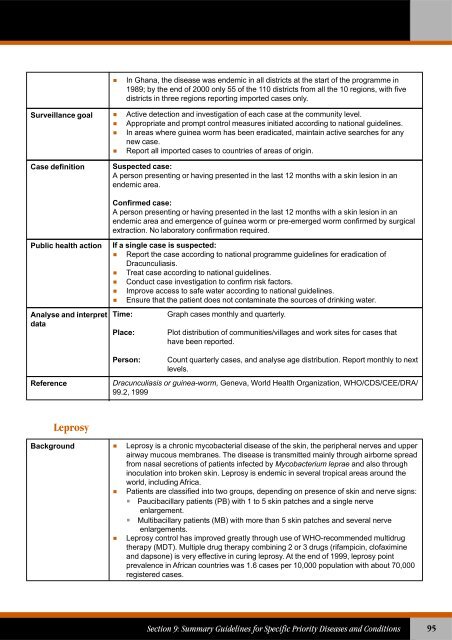Technical Guidelines for Integrated Disease Surveillance ... - PHRplus
Technical Guidelines for Integrated Disease Surveillance ... - PHRplus
Technical Guidelines for Integrated Disease Surveillance ... - PHRplus
Create successful ePaper yourself
Turn your PDF publications into a flip-book with our unique Google optimized e-Paper software.
In Ghana, the disease was endemic in all districts at the start of the programme in1989; by the end of 2000 only 55 of the 110 districts from all the 10 regions, with fivedistricts in three regions reporting imported cases only.<strong>Surveillance</strong> goal Active detection and investigation of each case at the community level. Appropriate and prompt control measures initiated according to national guidelines. In areas where guinea worm has been eradicated, maintain active searches <strong>for</strong> anynew case.Report all imported cases to countries of areas of origin.Case definitionSuspected case:A person presenting or having presented in the last 12 months with a skin lesion in anendemic area.Confirmed case:A person presenting or having presented in the last 12 months with a skin lesion in anendemic area and emergence of guinea worm or pre-emerged worm confirmed by surgicalextraction. No laboratory confirmation required.Public health actionAnalyse and interpretdataReferenceIf a single case is suspected: Report the case according to national programme guidelines <strong>for</strong> eradication ofDracunculiasis. Treat case according to national guidelines. Conduct case investigation to confirm risk factors. Improve access to safe water according to national guidelines.Ensure that the patient does not contaminate the sources of drinking water.Time:Place:Person:Graph cases monthly and quarterly.Plot distribution of communities/villages and work sites <strong>for</strong> cases thathave been reported.Count quarterly cases, and analyse age distribution. Report monthly to nextlevels.Dracunculiasis or guinea-worm, Geneva, World Health Organization, WHO/CDS/CEE/DRA/99.2, 1999LeprosyBackground Leprosy is a chronic mycobacterial disease of the skin, the peripheral nerves and upperairway mucous membranes. The disease is transmitted mainly through airborne spreadfrom nasal secretions of patients infected by Mycobacterium leprae and also throughinoculation into broken skin. Leprosy is endemic in several tropical areas around theworld, including Africa. Patients are classified into two groups, depending on presence of skin and nerve signs:Paucibacillary patients (PB) with 1 to 5 skin patches and a single nerveenlargement.Multibacillary patients (MB) with more than 5 skin patches and several nerveenlargements. Leprosy control has improved greatly through use of WHO-recommended multidrugtherapy (MDT). Multiple drug therapy combining 2 or 3 drugs (rifampicin, clofaximineand dapsone) is very effective in curing leprosy. At the end of 1999, leprosy pointprevalence in African countries was 1.6 cases per 10,000 population with about 70,000registered cases.Section 9: Summary <strong>Guidelines</strong> <strong>for</strong> Specific Priority <strong>Disease</strong>s and Conditions95















